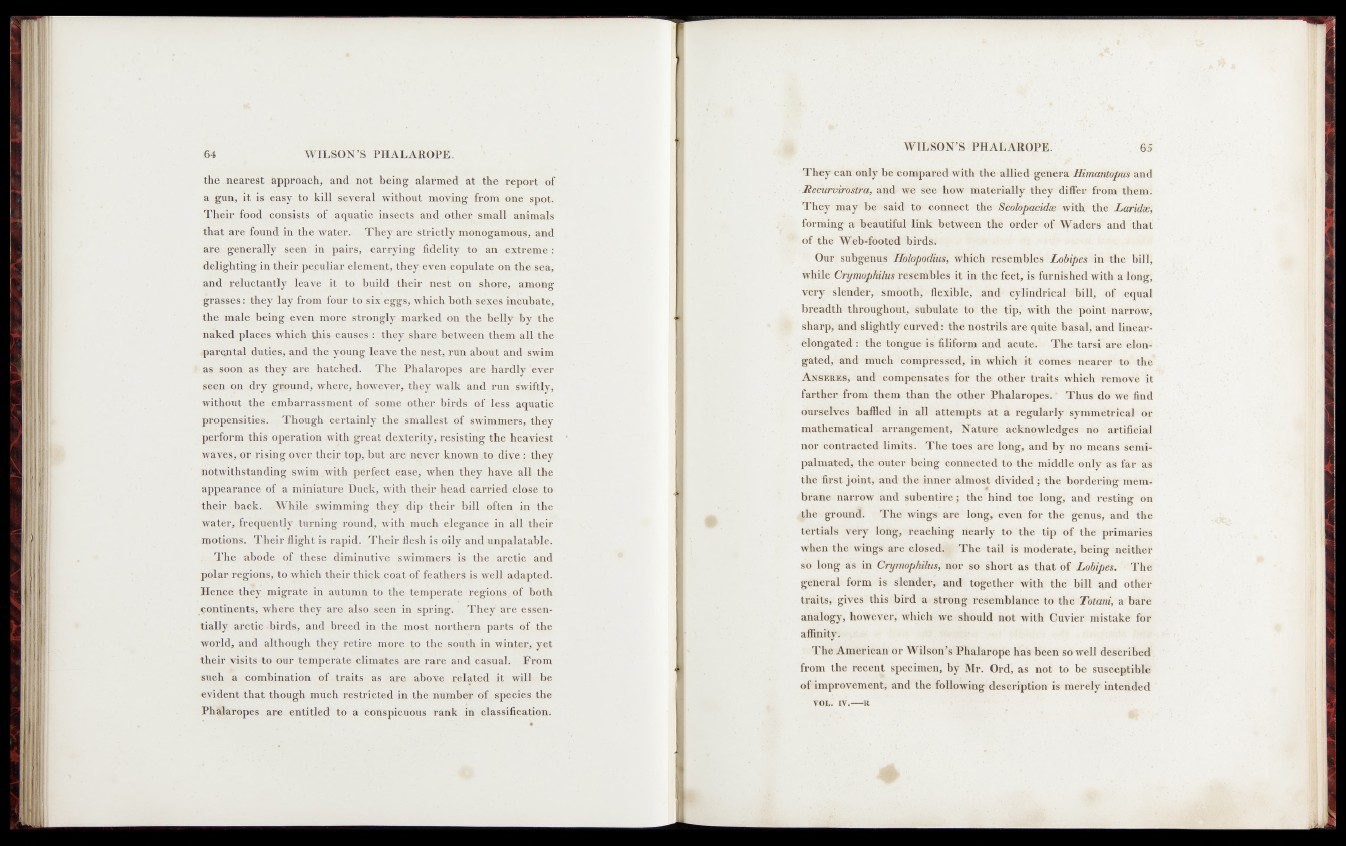
64 WILSON’S PHALAROPE.
thé ..nearest approach, and not being alarmed at the report of
a gun, it is easy to kill several without moving from one spot.
Their food consists of aquatic insects and other small animals
that are found in the water. They are strictly monogamous, and
are generally seen in "^iairs, carrying fidelity to an extreme :
delighting in their peculiar element, they even copulate on the sea,
and reluctantly leave it to build their nest on shore, among
grasses: they lay from four to six eggs, which both sexes incubate,
the male being even naore strongly marked on,the belly-by the
naked places Which this- causes : 1 they share; between them all the
«parental duties, and the yöung leave the nest, run about and swim
as soon as they are hatched. The Phalaropes are hardly ever
seen on # 6y gj®f>und, where, however, they Walk and run Swiftly,
without the embarrassment of some -other birds of less aquatie
propensities. • Though certainly the .smallest of swimmers,.they
perform this operation with great dexterity, resisting the heaviest
wayfes, or rising over their top, but are never known .to dive i^they,
notwithstanding swim ,with perfect ease, when they have alLthe
appearance of. a miniature Duck, with their, head carried close to
their back. ^WhRe ,#Wimming they dip their bill. often i n ’the
water', frequently turning round, with much elegance in all their
ipotib»«. Their flight is rapid, heir flesh is oily and unpalatable.
. The abodt%; of these diminutive swimmers is the arctic and
polar-regions, to which their thick coat of feaEtherS is well adapted.
Hence they. ^IgrUte.in autumn to the temperate regions, óf both
Continents, where they are also seen in spring. They 'are essentially.
arctic .birds, and breed in the most northern parts of the
world, and although ftiéy i?etire more, to the south in winter, yet
their visits to our teinperate climates are rare and casual. Erom
such au^mbinatiën, of traits-as •. it will be
evident that though much restricted in the number óf species the
Phalaropes are entitled to a conspicuous rank in classification.
■'They can only he ©oi^pared wifh the ailded genera Ilimantopus and
Mecurviroiti'a, and we see how materially they differ from them.
They may be said t®’ ©oSKect the Bcdl@p(i<ddee-w\\k the Land#,
forming a beautiful link between the order of W'aders and that
' of'the-* Web*foo®ed birdste - j
Our subgenus Holopodius, which resembles in the bill,
while Crymophilm -resembles it in the feet, is fttrhished with a long,
very^ slehder, slnboth; flexible^ and- cyAtedideal hill, of equal
breadth throughout, Subulate to .the tip/ -with the point narrow;
sharp, and slightly curved: the nostrils are qMte hasuil, and linear-
elongated ; the tongue is filiform and acute. The tarsi’are elongated,
and much compressed, in which it comes nearer to the*
Anserbs, and compensaies for the other traits which remove it
farther from them than the other Phalaropes. " Thus do we find
ourseFves baffled in all attempts at a regularly symmetrical o*
mathematical. arrangement, Nature acknowledges no artificial
nor contracted limits. The toes are fehg, and by ®> means semi-
palmatedy the outer being connected f» the middle only &s far as
the first joint, and the inner almost divided/ the hqrderiag mem-
brahe narrow and subentire; the hind toe long, and /©sting on
$lie grouna. The wings are long, even fer tbe gemas, an>d the
tertials very long, reaching dearly to the tip of the primaries
when the wings are closed^/The tail is moderate, heing neithet
so long as in Crymophilm, mm: so sbbk as that M ZoBipes. - 'lif e
general form is slender, and together with- the bill %nd other
traits, gives this bird a strong resemhlance to the Totani, a bate
analogy, however, which we should hot with Cuvier mistake for
affinity, .
The American or Wilson’s Phalarope has been so well described
from the recent specimen/ by Mr. Ord, as not to be susceptible
of improvement, and the following description is merely intended
■ VOLi IV.tHR,